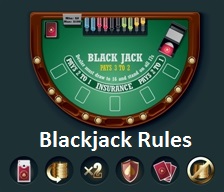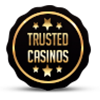Blackjack Rules

Blackjack Rules
With so many different blogs about Blackjack and how to play guides out there on the internet, we often see some bad advice given by people that have either never played Blackjack or written by hot shot wanner-be Blackjack players that actually turn over a consistent loss.
Of course the most obvious piece of advice you will always hear is that the objective of Blackjack is to make sure any hands you are playing get as close to 21 as possible without going bust. In actual fact this is more of a rule rather than objective.
‘The real objective of Blackjack is to beat to the dealer’
· Beat the dealer by making sure your hand doesn’t bust over 21
· Beat the dealer by sticking and allowing the dealer to go bust
· Outscore the dealer when neither you or the dealer go bust
(Effectively get a score closer to 21 than the dealer)
Rules of Blackjack
Table of Contents
If you would like to set up your own home game or understand some of the rules of Black, then read on!
Set up
· Blackjack games can have between 1 and 8 decks
· The player and dealer are dealt 2 cards each
· Players cards are dealt face up
· The dealer has 1 card facing down and 1 card face up
Card Values
· Aces count as a 1 score or a 11 point score towards your total bet
· All picture cards count as 10 points
· Every other card in the game is scored according to its number – so 2 to 10 are counted at what is called pip value
Blackjack Hand Values
· An Ace and any card valued at 10 is known as a Blackjack hand
· The Ace and 10 value card is a Blackjack 21 score and beats any other 21 point hand
(This means a 2 card Blackjack hand beats all other 21 point hands)
· You can have as many cards as you can get in your hand to make a 21
Additional Betting Options
· If the dealer’s face-up card is an Ace you will be offered to take out a side bet known as ‘insurance’. You have the option to bet half the amount wagered on the original bet
· If you choose to take the insurance bet, the dealer will look at his/her face down card and if it has a 10 value, the dealer turns over the card and the player is paid out at odds of 2-1.
· If the dealer has a 10 or an Ace, he/she will look at the other card, and if the face down card makes a Blackjack, then the dealer will show the player and all bets are lost resulting in a push aside from the ‘insurance’ bet, which the dealer will honour
· Many Blackjack games also come with side bets; for example, you may get paid for have 4 black cards in your hand or 4 aces in your hand
Sequence of Play
· Players always act before the dealer
· On multi player tables or multi-hand games, the dealer will always start with the hand to his/her left, which conversely is the hand to the player’s right
· Once the player has finished, it is the dealer’s turn to act. The dealer will only act if the player has not gone ‘bust’.
Player Actions and Moves
· Stand: Players can stand pat choosing not to hit for any more cards.
· Hit: Choosing to hit will mean the dealer will draw another card to add to the player’s hand. If the next card does not send the hand over ‘21’ to bust, then the player can hit again and continue to hit as many times as he/she wishes as long as he/she continues without going over 21
· Double Down: This is when a player doubles his/her bet. When this happens, the player can only draw for 1 more card on that particular hand. Usually you can only double on the first move, but there are also tables that allow a soft double down so you can double for 1 more card with 3 or 4 cards already laid out on your hand
· Split: When the dealer deals a pair or 2 cards with a value of 10, players can choose to split the hand into 2 separate hands. This requires the player to place an additional bet on the new hand. The dealer will then add an extra card to each hand at which point players can then ‘stand’, ‘hit’ or ‘double’ as normal starting with the dealer’s left most hand being the player’s right most hand. Should the player get a 21 when the dealer places an extra card on the split hands, then this hand will only count as a 21 and not a Blackjack. In addition, if players get another pair, they have the option to re-split up to a maximum of 4 times. Note: Some tables do not allow players to re-split Aces
· Surrender: Before the player chooses to ‘stand’ or ‘hit’ he/she may surrender the hand and have half the wager placed on the hand returned. Note: Some casinos or online tables do not have the surrender option.
Dealer Actions
· Once the player has finished, the dealer will turn over his/her cards.
· When the dealer has a total of 16 or less, then the dealer will be forced to draw for another card. The dealer will stop drawing once the score totals more than 16
· In situations where the dealer has a score of 17 via an Ace and a 6 card or any number of cards equalling 6, then this is known as a soft 17. On some tables the dealer must hit on a soft 17.
· Should the dealer hit and go over 21, then the dealer is bust and all players with active hands (hand not gone bust) will win.
· If the dealer has a score of 17 or above, then the dealer will ‘stand’ unless the rules stipulate hitting on a soft 17.
Blackjack Pay-outs
· If you beat the dealer, then the pay-out is even odds. That means you get your money back and the same amount on top effectively doubling your bet. For example, if you bet $10 and win, then you will get $20 in return making a $10 profit.
· With a Blackjack, you are paid out at 3 to 2 odds. This means that for a $10 bet, you would get back your $10, and another $15 on top totalling $25 and a $15 profit.
· As mentioned, insurance is paid at 2-1. If your wager is 50% of the original bet and we use the $10 bet as an example, then you will get $10 back plus your $5 bet. This is a $5 profit.
· For any side bet pay-outs, you will need to read the rules stipulated for the side bet in the section provided by the casino
Shortfalls on different variations of Blackjack
Increasingly in the land based casinos, but rarely online, there are short pays on hands such as Blackjack not to give the house a better edge, but simply to increase the table’s profit.
On these tables Blackjack is not paid at 3 to 2 and rather they opt for a 6 to 5. There are others that just pay even odds, the odd table paying 7-5. Let’s make this a little clearer using a simple $10 bet.
· 3 to 2 = $25 paid ($10 back plus $15 profit)
· 7 to 5 = $24 paid ($10 back plus $14 profit)
· 6 to 5 = $22 paid ($10 back plus $12 profit)
· Evens = $20 paid ($10 paid plus $10 profit)
One of the latest claims is that in Las Vegas around 10% of the Blackjack tables today pay less than the 3 to 2 odds that are standard Blackjack pay-outs.
If the odds are not 3 to 2 for Blackjack it’s 21
Basically any table that falls short of the odds of the normal game of Blackjack should not be treated as Blackjack because it ruins the strategy and pay back odds. In effect, these games are basically 21. This includes games like Spanish 21 or the Super Fun 21 game found online and in most brick and mortar casinos.
Always check the table you are playing for the pay back odds on the felt area or ask the dealer what the pay backs are for Blackjack.
Different Variations of Blackjack
There are many Blackjack variations and essentially the rules will vary from casino to casino. Some casinos stick to one set of rules; while, others have a more diverse Blackjack floor with tables that come with multiple game styles and multiple choice whether you want to play at tables with side bets.
· 1 deck blackjack
· 2 deck blackjack
· 4 decks or more
· European Blackjack
· Vegas Strip Blackjack
· Blackjack Hi/Lo 13
Table of The House Advantage on Number of Decks:
| 52-card pack decks | The House advantage |
|---|---|
| Single deck | 0.17% |
| Double deck | 0.46% |
| Four decks | 0.60% |
| Six decks | 0.64% |
| Eight decks | 0.65% |
One of the most diverse Blackjack tables you can play online is Microgaming’s Premier Blackjack with multiple tables, the choice to play single hands or multiple hands and a diverse set of side betting options that are determined by the hand you have. For example, you can get paid for having a pair, paid even more for having a pair of the same suit and even better Aces of the same suit.
A Simple Optimised Vegas Strip Blackjack Strategy
This is a strategy whereby the cost of an incorrect play, so not playing to the optimised level, would only be 0.14%. In the past the original version of this strategy had a cost that was 0.53%, but this was still too high and so since then a newer and better strategy has been tried and tested.
Depending on the version you play, you will get slight variations, but in essence the optimal strategy can be worked around each version. The more extra moves the table allows; such as, surrender, re-splits, soft double downs and so on, the more you can play with this particular strategy.
The main problem for most Blackjack players, is that they wither do have time, or do not have the patients to learn a strategy that is tough to memorise. In addition, much of the time learning a strategy and memorising it can be both tedious thus taking the fun out of the game, and also frustrating when a player gets it badly wrong.
Basically, this simple strategy gives players a 0.14% error margin over a 12 hour session using 21 cells to remember; whereas before there were over 250! Admittedly it is not full proof and doesn’t pull off 100% of the time, but with practise and patients you will get something out of it. Plus, you may even find ways to add your own little twist.
Hard hand & soft hand terminology explained
In this strategy you will hard hands and soft hand mentioned. You need to understand this terminology and then use these 2 sets to determine the 5 outcomes below.
Hard Hand = this hand can either have no aces involved, or the Ace is forced to count as an 11. This would be with a 3-A hand for example counting as 11 + 3 = 14 prior to the player acting.
Soft Hand = a hand that has at least 1 Ace involved that can count as either a 1 or 11.
· Double when your starting 2 cards score a 10 or 11 beating the dealer
Using this terminology you can a hard hand 10 or 11 (When your starting 2 cards come to 10 or 11) and you can double down on the hand as long as your total already beats the dealer’s face up score treating an Ace as an 11. Effectively, this means you would double if the dealer has a 2 to 9 card face-up and your hand scores 10 and double with an 11 versus 2 to 10
· Double if you have 9 versus 2 to 6
You should also double down if your hand is a 9 and the dealer has 2-6. Any other dealer face-up card you would hit
· Table does not allow a soft double
When you are forbidden to double when you have already hit for another card, and the rules say you should be doubling, then you should instead just choose to hit anyway. Yet, you should always stand on a soft 18 hand. Always treat the dealers Ace an 11 in this scenario
· Surrender is not allowed on your chosen table
In situations where it is suggested you surrender whereby you have a 16 score versus the dealer’s face up card being a 10, but the surrender option is not allowed, then you should hit. This is stated as a 16 versus a 10
3 negative Blackjack strategies that are very common
Amazingly the most popular strategies in Blackjack commonly used are the worst way to play.
These include the following:
· Never go bust: If you attempt to never bust, then the house gets an additional edge of 3.91%. That doesn’t mean hit every time, but you should avoid standing too often.
· Copy the dealer’s rules: The dealer hits on anything below 16 and stands on 17 or anything above 17. The player would also never double or split as the dealer does not perform these actions. If you do this, the house gets an edge on you of 5.48%.
· Assume that the dealer has a ten face down card: Always assuming the dealer has a 10 with an Ace face up card after dealer has already been peaking for Blackjack gives the house an edge of 10.03%. This is a tough one to calculate because you need to figure out the percentage of repetitive Blackjack.
Obviously you may not agree with everything here, and you do not have to agree with entire strategy. However, the rules are the rules, and hopefully now you have a good idea of how Blackjack can vary and what the common Blackjack rules are. As mentioned earlier, make sure you only play tables that pay 3-2 for Blackjack for an optimal pay back strategy and ignore those tables that are basically 32 unless you feel like a game of 21 that is. Good luck!
Other Casinos.org.uk Blackjack Articles You Might Enjoy:
- Best Blackjack Casinos
- How To Play BlackJack
- Blackjack Rules
- Card Counting
- Blackjack Variants
- Single Deck Strategy
















